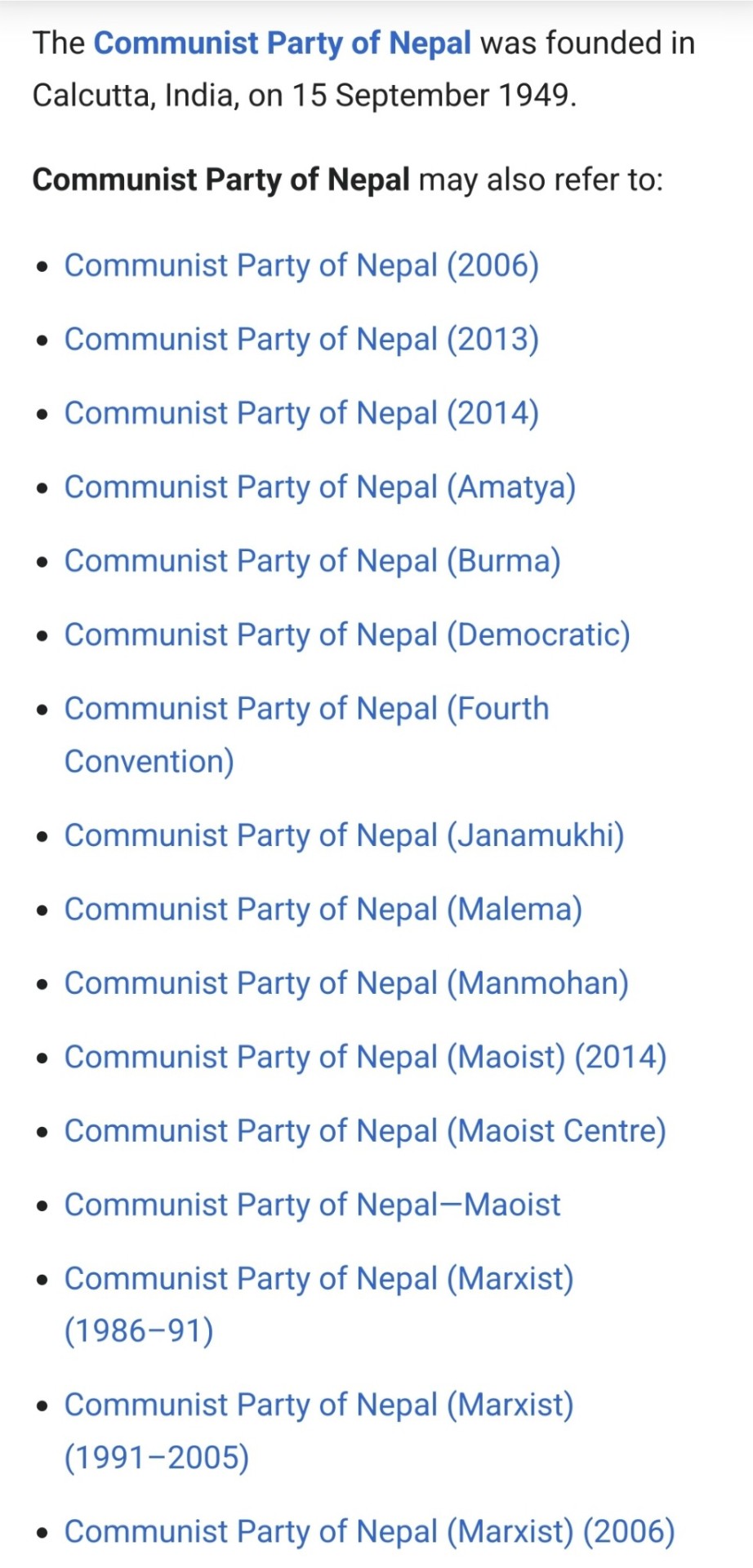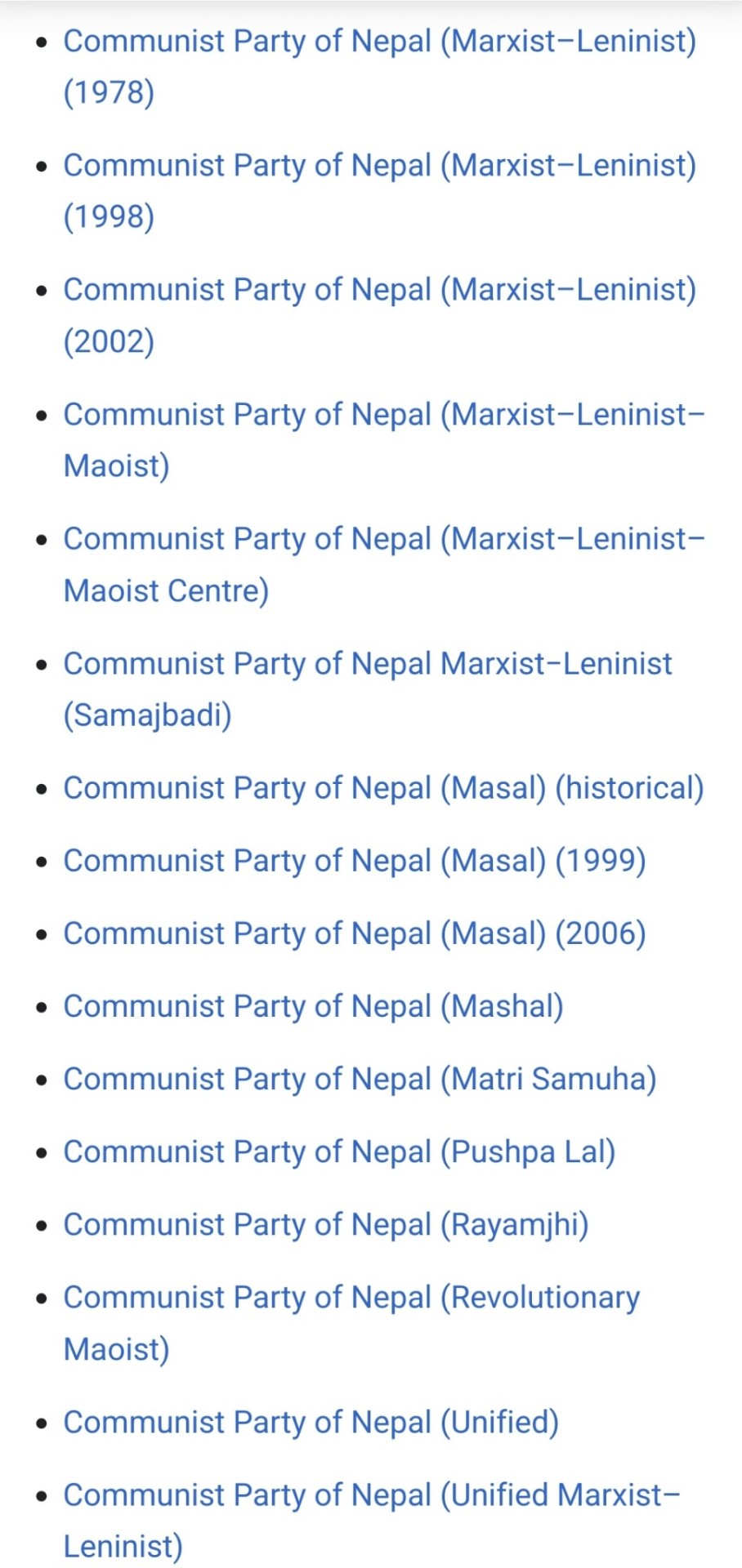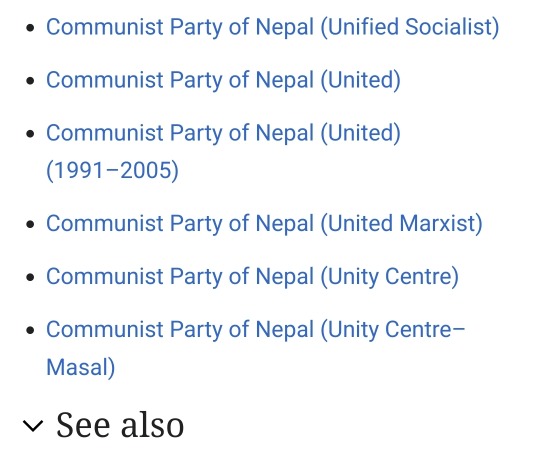#Nepal Communist Party
Photo

(via नेपाल कम्युनिस्ट पार्टीको पहिलो घोषणापत्र - क. पुष्पलाल)
0 notes
Text
Nepal Communist Party protest against India, stone pelting in embankment construction area
Nepal Communist Party protest against India, stone pelting in embankment construction area
Maoist Vipalva faction Communist Party activists demonstrated against India on Monday in Darchula Nepal. They also pelted stones in the Indian embankment construction area. The laborers working in the Indian territory somehow saved their lives by running away. The people of India are angry because of the incident.
Maoist insurgency groups gathered in Darchula Nepal under the leadership of…

View On WordPress
0 notes
Text
भक्तपुर जिससका लागि नेमकिपा निर्णायक
Nemkipa decisive for Bhaktapur Jesus
जिल्ला समन्वय समिति भक्तपुरको निर्वाचन यही जेठ २८ गते हुने भएको छ । मुख्य निर्वाचन अधिकृतको कार्यालयले यही १९ गते निर्वाचन कार्यतालिका सार्वजनिक गर्दै २३ गते उम्मेदवारी दर्ता र २८ गते निर्वाचन गर्ने जानकारी दिएको छ ।
मुख्य निर्वाचन अधिकृत गोपालप्रसाद बाँस्तोलाले १९ गते मतदाता नामावली प्रकाशनसँगै निर्वाचन प्रक्रिया सुरु भएको र निर्वाचन तालिकाअनुसार सबै प्रक्रिया पूरा गरेर २८ गते निर्वाचन गरी सोही…

View On WordPress
1 note
·
View note
Text
With a history of short-term governments in Nepal’s 15 years of democratic progression, the current reconfiguration is no surprise, and it will be no surprise if the Maoists get back again with the Nepali Congress in months and years to come.
Power sharing, political discontent, ideological differences, underperformance, and pressure to restore Nepal to a Hindu state – a long list of reasons reportedly forced the Maoists to sever ties with the Nepali Congress. While the Nepali Congress expected the Maoist leader and current prime minister, Pushpa Kamal Dahal (also known by his nom de guerre, Prachanda) to leave the alliance, it did not expect an overnight turnaround. [...]
Dahal reportedly conveyed to the Nepali Congress chair, former Prime Minister Sher Bahadur Deuba, that external pressure forced him to join hands with CPN-UML and form a new government.
If this assertion is true, China emerges as a plausible factor, given its historical inclination toward forging alliances with leftist parties in Nepal. This notion gains credence in light of China’s past efforts, such as its unsuccessful attempt in 2020 to mediate the conflict between Oli and Dahal.
On the other hand, India has enjoyed a comfortable working relationship with the Nepali Congress and the Maoists. Although Maoists were a challenging party for New Delhi to get along with when Dahal first gained the prime minister’s seat in 2008, the two have come a long way in working together. However, the CPN-UML has advocated closer ties with the northern neighbor China; Beijing suits both their ideological requirements and their ultra-nationalistic outlook – which is primarily anti-India. [...]
India faces challenges in aligning with the Left Alliance for two key reasons. First, the energy trade between Nepal and India has grown crucial over the past couple of years. However, India strictly purchases power generated through its own investments in Nepal, refusing any power produced with Chinese involvement. With the CPN-UML now in government, Nepal may seek alterations in this arrangement despite the benefits of power trade in reducing its trade deficit with India.
Second, India stands to lose the smooth cooperation it enjoyed with the recently dissolved Maoist-Congress coalition. During the dissolved government, the Nepali Congress held the Foreign Ministry, fostering a favorable equation for India. Just last month, Foreign Minister N.P. Saud visited India for the 9th Raisina Dialogue, engaging with top Indian officials, including his counterpart, S. Jaishankar.
As concerns arise for India regarding the Left Alliance, there is also potential for shifts in the partnership between Nepal and the United States, a significant development ally. Particularly, there may be a slowdown in the implementation of the Millennium Challenge Corporation (MCC) projects. Despite facing domestic and Chinese opposition, the Nepali Parliament finally approved a $500 million MCC grant from the United States in 2022, following a five-year delay.
China perceives the MCC as a component of the U.S.-led Indo-Pacific strategy, countering its BRI. Hence Beijing aims to increase Chinese loans and subsidies to Nepal to enhance its influence.
To conclude, the re-emergence of Nepal’s Left Alliance signals a shift in power dynamics, impacting domestic politics and regional geopolitics. With China’s influence growing, Nepal’s foreign policy may tilt further toward Beijing, challenging India’s interests. This shift poses challenges for India, particularly in trade and diplomatic relations, while also affecting Nepal’s partnerships with other key players like the United States.
[[The Author,] Dr. Rishi Gupta is the assistant director of the Asia Society Policy Institute, Delhi]
6 Mar 24
229 notes
·
View notes
Text
In the waters of the South China Sea, Chinese coast guard vessels have clashed with Philippine ships. In the air above the Taiwan Strait, Chinese warplanes have challenged Taiwanese jet fighters. And in the valleys of the Himalayas, Chinese troops have fought Indian soldiers.
Across several frontiers, China has been using its armed forces to dispute territory not internationally recognized as part of China but nevertheless claimed by the Chinese Communist Party (CCP).
In August 2023, Beijing laid out its current territorial claims for the world to see. The new edition of the standard map of China includes lands that are today a part of India and Russia, along with island territories such as Taiwan and comprehensive stretches of the East and South China Seas that are also claimed by Brunei, Indonesia, Japan, Malaysia, the Philippines, and Vietnam.
China often invokes historical narratives to justify these claims. Beijing, for example, has said that the Japanese-administered Senkaku Islands, which it claims under the name of the Diaoyu Islands, “have been an inherent territory of China since ancient times.” Chinese officials have used the same words to back China’s right to parts of the northeastern Indian state of Arunachal Pradesh. The Chinese government also claims that its sovereignty over the South China Sea is based on its own historic maritime maps.
However, in certain periods since ancient times China has also held sway over other states in the region—Mongolia, North Korea, South Korea, and Vietnam. Yet Beijing is currently not laying claim to any of these.
Instead, Beijing has embraced a selective irredentism, wielding specific chapters of China’s historical record when they suit existing aims and leaving former Chinese territories be when they don’t. Over time, as Beijing’s interests and power relations have shifted, some of these claims have faded from importance, while new ones have taken their place. Yet for Taiwan, Chinese claims remain unchanged, as the fate of the island state is tied to the very legitimacy of the CCP as well as the vitality of Chinese President Xi Jinping’s political vision.
Many of the CCP’s territorial claims have roots in the 19th and 20th centuries during the late rule of the Qing Dynasty. Following diplomatic pressure and repeated military defeats, the Qing Dynasty was forced to cede territory to several Western colonial powers, as well as the Russian and Japanese empires. These concessions are part of what are known in China as the “unequal treaties,” while the 100 years in which the treaties were signed and enforced are known as the “century of humiliation.” These territorial losses eventually passed from the dynasty to the Republic of China and then, following the Chinese Civil War, to the CCP. As a result, upon the CCP’s establishment of the People’s Republic of China in 1949, the new Chinese state inherited outstanding territorial disputes with most of its neighbors.
But despite the humiliation the Qing Dynasty’s losses had caused, the CCP proved willing to compromise and reduce its territorial aims during times of high internal unrest. Following the Tibetan uprising in 1959, for instance, the CCP negotiated territorial settlements with countries bordering the Tibet region, including Myanmar, Nepal, and India. Similarly, when unrest rocked the Uyghur region in the 1960s and ‘90s, Beijing pursued territorial compromises with several bordering countries such as Afghanistan, Kazakhstan, Kyrgyzstan, and Tajikistan. In the aftermath of the Great Leap Forward in the early 1960s and the 1989 Tiananmen Square Massacre, the CCP also pursued territorial settlements with Mongolia, Laos, and Vietnam in the hopes of securing China’s borders during times of domestic instability. Instead of pursuing diversionary wars, the CCP relied on diplomacy to settle border and territory disputes.
But China has changed quite a lot since then. In recent years, the CCP has avoided the inflammatory domestic political chaos of previous decades, and its once-tentative hold over border regions, such as Tibet and the Uyghur region, has been replaced by an iron grip. With this upper hand, the CCP has little incentive to pursue peaceful resolutions to remaining territorial disputes.
“China’s national power has increased significantly, reducing the benefits of compromise and enabling China to drive a much harder bargain,” said M. Taylor Fravel, a political science professor at the Massachusetts Institute of Technology.
In this context, the CCP has expanded its irredentist ambitions. After the discovery of potential oil reserves around the Senkaku Islands, and the United States’ return of the islands to Japan in the 1970s, Beijing drew on its historical record to lay claim to the islands, even though it had previously referred to them as part of the Japanese Ryukyu Islands. Similarly, though Beijing and Moscow settled a dispute over Heixiazi Island, located along China’s northeastern border, in 2004, the 2023 map of China depicted the entire island (ceded, along with vast Pacific territories, by the Qing Dynasty to the Russian Empire in 1860) as part of its domain, much to the ire of the Russian Foreign Ministry.
Collin Koh Swee Lean, a senior fellow with the S. Rajaratnam School of International Studies at the Nanyang Technological University in Singapore, argues that the Chinese mapping of Heixiazi Island shows that Beijing holds on to certain core interests and simply waits for the opportune time to assert them.
“Given the current context of the war in Ukraine and Russia’s increased dependence on China, it might have appeared to Beijing that it has the chips in its pockets because, after all, Moscow needs Beijing more than the other way around,” Koh said on the German Marshall Fund’s China Global podcast.
This raises the question of whether territorial disputes that were settled during times of CCP weakness can be revisited and become subject to irredentist ambitions should power balances shift in China’s favor.
According to Steve Tsang, the director of the China Institute at the University of London’s School of Oriental and African Studies, there is currently a limit to how far the CCP will push territorial claims against Russia, since President Xi will need Russian support to sustain his grand ambitions for Chinese leadership on the global stage.
Although it would be a long shot, even Russia may not be safe from these ambitions indefinitely. Given that large swaths of Russia’s Pacific territories were part of China until 1860, “China could claim back the Russian Far East when it deems the time is right,” Tsang said. Such control would grant Beijing unrestricted access to the region’s abundance of coal, timber, tin, and gold while moving it geographically closer to its ambition of becoming an Arctic power.
While there is plenty of historical evidence pointing to former Chinese control over the southeastern portion of the Russian Far East, the historical record is less unequivocal about Chinese control over Taiwan. Anything resembling mainland Chinese control over Taiwan was not established until after 1684 by the Qing Dynasty, and even then central authority remained weak. In 1895, the Qing Dynasty ceded Taiwan to the Empire of Japan following the First Sino-Japanese War, and by the time Chinese authority was restored in 1945, Taiwan had undergone several decades of Japanization.
These details have not prevented the CCP from claiming that Taiwan has been an inalienable part of China since ancient times. Yet more than any other irredentist claim, Xi has made unification with Taiwan a major component of his vision to rejuvenate the Chinese nation.
Unification, however, has little to do with ancient history and more to do with the challenge that Taiwan presently poses to Xi’s aims, according to Chong Ja Ian, an associate professor who teaches about Chinese foreign policy at the National University of Singapore.
“The CCP pursues a Chinese nationalism that emphasizes unity and homogeneity centered around the CCP leadership while they also often claim that their single-party rule is acceptable to Chinese people,” Chong said.
In contrast, Taiwan holds free elections in which multiple political parties compete for the favor of a people that have increasingly developed an identity distinct from mainland China.
“The Taiwanese experience is a clear affront to the CCP narrative,” Chong said.
Control over Taiwan is also attractive to Beijing because it is key to unlocking the Chinese leadership’s broader ambition of maritime hegemony in waters where almost half of the world’s container fleet passed through in 2022.
As with the case of Taiwan, the CCP’s historical arguments regarding its claims on island groups and islets in the East and South China Seas are likewise much weaker than many of its land-based claims.
Instead, Chinese territorial intransigence in the maritime arena is more about a strategic shift in the value of the seas around China, Fravel said.
Today, it has been estimated that more than 21 percent of global trade passes through the South China Sea. And beneath these waters are not only subsea cables that carry sensitive internet data but also vast estimated reserves of oil and natural gas.
Although it may say otherwise, Beijing’s unwillingness to let up on its tenuous territorial maritime claims suggests that China is pursuing long-held ambitions and global aspirations rather than attempting to reverse past losses. So long as the CCP wields its historical record selectively and changeably to serve its aims—and is willing to back its claims up with military action—China’s neighbors will remain at risk.
19 notes
·
View notes
Text
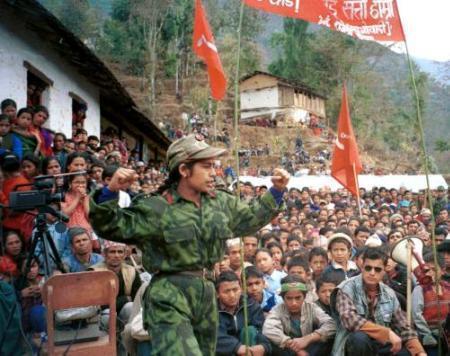
A Maoist rebel speaks to villagers around the area of Piskar, Nepal, during the civil war.
The Peoples Liberation Army (PLA) military wing of the Communist Party of Nepal (Maoist) (CPN(M))
135 notes
·
View notes
Text
Jhumpa Lahiri’s The Lowland (2013) and Neel Mukherjee’s The Lives of Others (2014), that embody this tendency: a universalization that, in fact, neither comprehends nor sympathizes with the social and political contradictions in contemporary South Asia.
Both novels place at the center of their narrative what is commonly referred to as the Naxalite movement, which began in 1967 with a peasant uprising in Naxalbari, a village in northern Bengal near the Nepal border. Initially led by armed members of the Communist Party of India (Marxist), the movement later broke away to form the Communist Party of India (Marxist-Leninist) and has largely followed Mao’s doctrine of “people’s war.” Begun in the countryside, it spread to the cities during the 1970s, attracting significant numbers of educated, unemployed youth energized by the peasants’ struggle for rights and recognition. A brutal counteroffensive, empowered by draconian anti-terrorist laws, brought the first phase of the movement to an end. In both novels, the central figures are Naxalite militants. Their immersion in the movement, together with the fallout of their decisions on the lives of those around them, largely propels the narrative in both.
By placing an emancipatory movement at the core of their novels, Lahiri and Mukherjee also place the politics of resistance front and center. And yet, even though both novels are structured by the political actions of key characters, neither author is able to muster an empathetic understanding of their characters’ actions. Moreover, the very idea of a life of struggle is made to appear at best quaint, at worst objectionable. In both novels, politics remains something imposed on the characters, an external, impinging force—but never a source of self-actualization. Instead it serves as a source of dislocation, self-doubt, broken relationships and disrupted lives. Each novel exposes its author’s inability to perceive the political as an intrinsic aspect of the individual being.
Hence, while each of the authors locates a politics of resistance at their novel’s center and views that politics through a universalizing prism, neither can fathom its attraction. Such an approach to emancipatory politics reinforces the neoliberal view that all resistance is doomed because there are no possible alternatives to the current order. And although both authors seem to want to escape an ethos where resistance is viewed as futile, neither is able to do so. As a result, neither is able to engage, much less express, the internal lives of their own central characters. Because of this, they remain limited, not just as post-colonial novels but simply as novels.
The World In a Grain of Sand, Nivedita Majumdar (emphasis mine)
#postcolonial literature#litcrit#the central narrative of jhumpa lahiri's lowland is... killing cops is bad and will bring emotional vengeance upon you wtf#it makes her other novels look really inoffensive tbh#nivedita majumdar#diaspora lit
92 notes
·
View notes
Note
you ever notice how all the other communists are also middle class white american men and anyone from a country where it's actually been tried knows its a bad idea?
This laughably, patently, and observably untrue and it’s honestly hilarious people still say this line. Like, where do you want me to point? The 90+ million CPC members? Vietnam? Laos? Cuba? The DPRK? The large margin of approval people in the FSU have for the USSR who were alive when it still existed? The powerful and massive communist parties in India, Nepal, the Philippines, Russia, Kenya, Brazil, and elsewhere? My mutuals who live in the global south? The Black and brown people who make up the overwhelming majority of my own party? You may as well have left an anon saying “funny how the sky is orange when you people keep saying it’s blue.” Go talk yourself to death in a corner somewhere.
249 notes
·
View notes
Text
Tibetan Uprising Day 2024 and a Half-Forgotten Human Rights Disaster
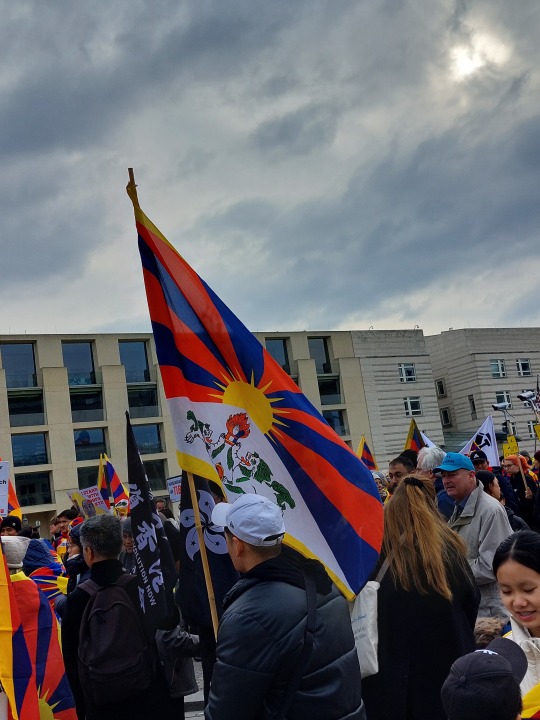
Protesters on Tibetan Uprising Day at Pariser Platz. Berlin, March 10, 2024. Photograph by me (Edith Haimberger). All rights reserved.
"Tibetans inside Tibet: We are with you!"
— sign at Berlin protest on March 10, 2024
The red, yellow and blue colours of Tibet's flag flew across the Pariser Platz square behind Brandenburg Gate on Sunday as some 80 protesters gathered for Tibetan Uprising Day.
Reeducation camps for Uyghur Muslims in China, more rarely developments in Hong Kong, and controversies around the Dalai Lama who is the spiritual leader of Tibetan Buddhists, may dominate international news headlines.
But the plight of inhabitants in the Tibetan region that the protestors portrayed in signs, speeches, and information panels yesterday is no longer common knowledge.
A youngish man in jeans and a puffer jacket, who was walking across the square on Sunday, asked the police officer beside him who had mentioned Tibet, "Was ist das?" ('What is it?') The police officer, at least, knew the answer.
Miniature History
In 1950 the Chinese People's Liberation Army invaded the remote region bordering Nepal. Ever since then, the autonomy or even the independence of Tibet has been hotly disputed, as well as the measures through which the ruling Chinese Communist Party governs the country. Tibetan Uprising Day marks the anniversary of a revolt in 1959.
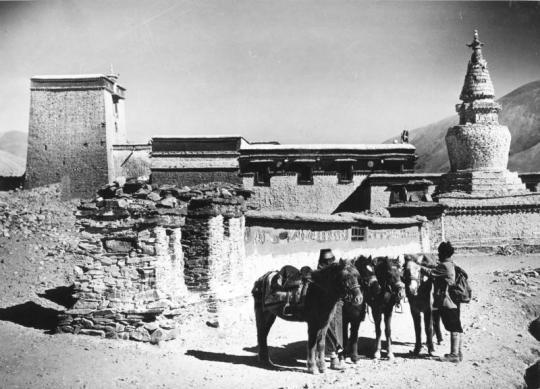
Image: "Tibetexpedition, Kloster in Samada." (Tibet Expedition, Convent [or Monastery] in Samada.) Photo taken by Ernst Krause in 1938.
Uploaded to Wikimedia Commons by the German Federal Archives.
'Many of us standing here today,' a speaker wearing traditional embroidered clothing told the crowd in Berlin, 'have never been in Tibet.'
Instead the protesters on Sunday were often exiles, many second-generation.
Their relatives in Tibet face systematic repression.
"Menschenrechte für Tibet"
"Freiheit für Tibet"
— 'Human rights for Tibet' and 'Freedom for Tibet.' Signs at the Berlin protest on March 10, 2024.
The Berlin speakers accused the Chinese Communist Party (CCP) of cultural genocide. Children as young as 5 years old are sent to residential boarding schools where they are educated as Chinese, while Tibetan language and culture are forbidden.
Monasteries and convents that were destroyed in the mid-20th century and only partly rebuilt in the 1980s remain vulnerable.
The Chinese government has been building massive hydroelectric dams in Tibet. Permission from Tibetans is not asked, a reporter from Tibet.tv said at the protest in Berlin. Instead, entire villages and monasteries, dating back even to the times where Europe was in the Middle Ages, are destroyed.
Local Tibetans who protest mega-dam projects are arrested and, at times, beaten.
A-Nya Sengdra, a nomad in Qinghai province, is in the middle of a 7-year prison sentence on charges like 'provoking trouble.' In a 2020 press release from the UN's Office of the High Commissioner for Human Rights, experts say that he had been active for example against "illegal hunting and poaching of endangered animals."
As his prison sentence continues, friends are worried for his health.
Outside Tibet, in his Indian exile of Dharamshala, the Dalai Lama has also spoken enigmatically about his successor as spiritual leader. He is 88 years old. The reincarnation of the Dalai Lama has a spiritual dimension for Tibetan Buddhists, but the Chinese Communist Party — a secular body —wants the next Dalai Lama to be approved by them first.
But, also explaining why Tibet is seldom in news headlines, it is difficult to obtain information from within the region. Writing for the Human Rights Watch website in 2022, an expert spoke of
draconian controls on the flow of information between Tibet and the outside world
*
The Heyday of International Awareness of Tibet
In the 1980s and 90s and early 2000s, Tibet was a cause célèbre.
Actress Sharon Stone and actor Richard Gere, who are Tibetan Buddhist, spoke out in favour of its independence.
The Tibet-inspired American fantasy film The Golden Child (1986) earned $149.4 million at the box office. In 1997, two films followed: Kundun, directed by Martin Scorsese, and Seven Years in Tibet .
When this reporter arrived in Germany in 2006, a string of Tibetan prayer flags crossed above a neighbourhood street.
Tourists were drawn to Tibet — this has not changed: it is estimated that 15 million of them visited in 2015.
But Tibet was not just famous in cultural spheres. In 1989, the Dalai Lama won the Nobel Prize for Peace.
*
Tenuous links exist between Tibetans in countries like Germany and Tibetans in the Tibetan Autonomous Region. But the CCP's surveillance extends beyond international borders. Telephone calls may be monitored, participation in protests by Tibetans in exile become a problem for relatives.

Young women at the Tibetan protest in Berlin, Germany, speak out against the Chinese Communist Party's gathering of DNA as part of a surveillance programme. Photograph taken by me (Edith Haimberger), on Sunday, March 10, 2024. All rights reserved.
Surveillance within Tibet is so severe that human rights organizations and activists reported in 2022 that the CCP are gathering DNA on a large scale — of hundreds of thousands of people, including schoolchildren — to track dissidents.
*
The Tibet Initiative Deutschland and the Gesellschaft für bedrohte Völker, two non-governmental groups, co-organized the Berlin protest on March 10.
The Gesellschaft noted on their social media that German Chancellor Olaf Scholz will travel to China in April.
In Tibetan communities in the country and abroad there are conflicting opinions on how to resist the Chinese Communist Party. Peacefully, through classic forms of protest? Through self-immolation?
"We know through painful experience that freedom is never voluntarily given by the oppressor; it must be demanded by the oppressed."
— Quoted during the March 10 protest. From Martin Luther King, Jr.: Letter from a Birmingham Jail (1963) [Wikiquote]
A speaker from the Tibet Initiative Deutschland described his group's campaign to persuade municipalities across Germany to raise the flag of Tibet over their town halls for Tibetan Uprising Day in solidarity. Over 400, he said, had agreed.
Efforts at the federal level by the German chancellor, foreign minister, and others on behalf of minorities' civil and political rights, however, are apparently often undermined by German corporations.
A representative of the Gesellschaft für bedrohte Völker told the crowd in front of the German Foreign Ministry yesterday:
Corporations doing business within China — the German foreign ministry reports in its China-Strategie publication that there are 5,000 of these — lobby for silence, fearing financial losses.
5 notes
·
View notes
Text
Nepal has *four* different Communist parties in its parliament.
#lol#and almost all the rest are either social democratic or democratic socialist#Nepalese politics is complicated
26 notes
·
View notes
Text
एमालेद्वारा बागमती प्रदेशसभा अवरुद्ध
UML blocks Bagmati Pradesh Sabha
बागमती प्रदेशसभाको बैठक अवरुद्ध भएको छ । बैठक सुरु भएलगत्तै नेकपा (एमाले)ले अवरोध गरेपछि बैठक केही समयका लागि स्थगन गरिएको छ ।
सरकारले प्रस्तुत गरेको आगामी आर्थिक वर्ष २०७९÷८० को नीति तथा कार्यक्रममाथि छलफल गर्न बसेको बैठक सुरु भएलगत्तै एमालेका सांसदले उठेर विरोध जनाउनुभएको थियो । त्यसपछि सभामुख सानुकुमार श्रेष्ठले एमालेका मुख्य सचेतक दीपक निरौलालाई आफ्ना भनाइ राख्न समय उपलब्ध गराउनुभएको थियो…
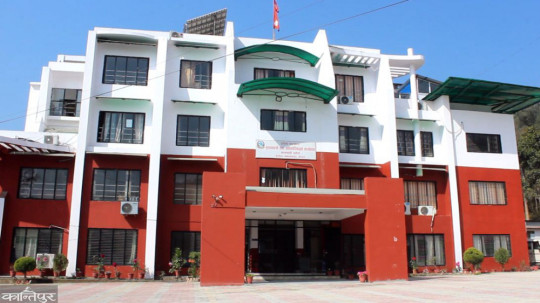
View On WordPress
0 notes
Text
In 2009 I used some kind of illegal WiFi to upload all my photos of Tibet to Flickr via a memory card and a netbook. This was so Chinese soldiers at the border with Nepal on the day after the Chinese Communist Party's 60th anniversary wouldn't delete any of my images. They DID rifle through my entire backpack, and through every page in my guidebook (in case I had photos of the Tibetan flag or Dalai Lama or anything "illegal"). They also "closed Mount Everest", but I was fortunate enough to get to base camp the day before that. We (foreigners) had to stay locked in our hotel on the day of the anniversary while soldiers marched through the streets and snipers sat on the rooftops opposite us. I had microwave popcorn for breakfast and the woman in the hotel kitchen had never seen it before, and she thought I was trying to blow up her microwave.
Anyway, I just deleted my subscription to Flickr on PayPal this morning.
4 notes
·
View notes
Text
Events 2.13 (after 1940)
1945 – World War II: The siege of Budapest concludes with the unconditional surrender of German and Hungarian forces to the Red Army.
1945 – World War II: Royal Air Force bombers are dispatched to Dresden, Germany to attack the city with a massive aerial bombardment.
1951 – Korean War: Battle of Chipyong-ni, which represented the "high-water mark" of the Chinese incursion into South Korea, commences.
1954 – Frank Selvy becomes the only NCAA Division I basketball player ever to score 100 points in a single game.
1955 – Israel obtains four of the seven Dead Sea Scrolls.
1955 – Twenty-nine people are killed when Sabena Flight 503 crashes into Monte Terminillo near Rieti, Italy.
1960 – With the success of a nuclear test codenamed "Gerboise Bleue", France becomes the fourth country to possess nuclear weapons.
1960 – Black college students stage the first of the Nashville sit-ins at three lunch counters in Nashville, Tennessee.
1961 – An allegedly 500,000-year-old rock is discovered near Olancha, California, US, that appears to anachronistically encase a spark plug.
1967 – American researchers discover the Madrid Codices by Leonardo da Vinci in the National Library of Spain.
1975 – Fire at One World Trade Center (North Tower) of the World Trade Center in New York.
1978 – Hilton bombing: A bomb explodes in a refuse truck outside the Hilton Hotel in Sydney, Australia, killing two refuse collectors and a policeman.
1979 – An intense windstorm strikes western Washington and sinks a 0.5-mile (0.80 km) long section of the Hood Canal Bridge.
1981 – A series of sewer explosions destroys more than two miles of streets in Louisville, Kentucky.
1983 – A cinema fire in Turin, Italy, kills 64 people.
1984 – Konstantin Chernenko succeeds the late Yuri Andropov as general secretary of the Communist Party of the Soviet Union.
1990 – German reunification: An agreement is reached on a two-stage plan to reunite Germany.
1991 – Gulf War: Two laser-guided "smart bombs" destroy the Amiriyah shelter in Baghdad. Allied forces said the bunker was being used as a military communications outpost, but over 400 Iraqi civilians inside were killed.
1996 – The Nepalese Civil War is initiated in the Kingdom of Nepal by the Communist Party of Nepal (Maoist-Centre).
2001 – An earthquake measuring 7.6 on the Richter magnitude scale hits El Salvador, killing at least 944.
2004 – The Harvard–Smithsonian Center for Astrophysics announces the discovery of the universe's largest known diamond, white dwarf star BPM 37093. Astronomers named this star "Lucy" after The Beatles' song "Lucy in the Sky with Diamonds".
2007 – Taiwan opposition leader Ma Ying-jeou resigns as the chairman of the Kuomintang party after being indicted on charges of embezzlement during his tenure as the mayor of Taipei; Ma also announces his candidacy for the 2008 presidential election.
2008 – Australian Prime Minister Kevin Rudd makes a historic apology to the Indigenous Australians and the Stolen Generations.
2010 – A bomb explodes in the city of Pune, Maharashtra, India, killing 17 and injuring 60 more.
2011 – For the first time in more than 100 years the Umatilla, an American Indian tribe, are able to hunt and harvest a bison just outside Yellowstone National Park, restoring a centuries-old tradition guaranteed by a treaty signed in 1855.
2012 – The European Space Agency (ESA) conducted the first launch of the European Vega rocket from Europe's spaceport in Kourou, French Guiana.
2017 – Kim Jong-nam, brother of North Korean dictator Kim Jong-un, is assassinated at Kuala Lumpur International Airport.
2021 – Former U.S. President Donald Trump is acquitted in his second impeachment trial.
2021 – A major winter storm causes blackouts and kills at least 82 people in Texas and northern Mexico.
2 notes
·
View notes
Text

Three Maoist rebels wait on top of a hill in the Ropla district for orders to relocate.
The Nepalese civil war that lasted 10 years resulted in the abolition of the monarchy, a new interim constitution and the entry of Maoists into mainstream politics.
The Peoples Liberation Army (PLA) military wing of the Communist Party of Nepal (Maoist) (CPN(M))
29 notes
·
View notes
Text
I love reading about socialists/communist parties across the world. On the one hand you have Western socialist parties that are worthless at best. And on the other hand, you have Nepal, where the government and opposition are made up of different Marxist-Leninist and Maoist parties that absolutely hate each other.
3 notes
·
View notes
